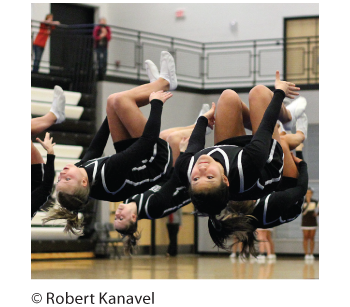Body Position and Movement
Without sensing your body’s position and movement, you could not put food in your mouth, stand up, or reach out and touch someone. Nor could you perform the “simple” act of taking one step forward. That act requires feedback from, and instructions to, some 200 muscles, and it engages brain power that exceeds the mental activity involved in reasoning. Like all your other voluntary movements, taking a step is possible because of your sense of kinesthesia, which keeps you aware of your body parts’ position and movement. You came equipped with millions of position and motion sensors in muscles, tendons, and joints all over your body. These sensors provide constant feedback to your brain. Twist your wrist one degree and your brain receives an immediate update.
You can momentarily imagine being without sight or sound. Close your eyes or plug your ears, and experience the dark silence. But what would it be like to live without touch or kinesthesia—without being able to sense the positions of your limbs when you wake during the night? Ian Waterman of Hampshire, England, knows. In 1972, at age 19, Waterman contracted a rare viral infection that destroyed the nerves enabling his sense of light touch and of body position and movement. People with this condition report feeling disembodied, as though their body is dead, not real, not theirs (Sacks, 1985). With prolonged practice, Waterman learned to walk and eat—by visually focusing on his limbs and directing them accordingly. But if the lights went out, he would crumple to the floor (Azar, 1998).
Vision interacts with kinesthesia for you, too. Stand with your right heel in front of your left toes. Easy. Now close your eyes and try again. Did you wobble?
A companion vestibular sense monitors your head’s (and thus your body’s) position and movement. The biological gyroscopes for this sense of equilibrium are two structures in your inner ear. The first, your fluid-filled semicircular canals, look like a three-dimensional pretzel (see Figure 20.2a). The second structure is the pair of calcium crystal-filled vestibular sacs. When your head rotates or tilts, the movement of these organs stimulates hair-like receptors, which send nerve signals to your cerebellum at the back of your brain, enabling you to sense your body position and maintain your balance.
If you twirl around and then come to an abrupt halt, neither the fluid in your semicircular canals nor your kinesthetic receptors will immediately return to their neutral state. The dizzy aftereffect fools your brain with the sensation that you’re still spinning. This illustrates a principle that underlies perceptual illusions: Mechanisms that normally give us an accurate experience of the world can, under special conditions, fool us. Understanding how we get fooled provides clues to how our perceptual system works.

Bodies in space Each of these high school competitive cheer team members can thank her inner ears for the information that enables her brain to monitor her body’s position so expertly.
One little known fact about your vestibular sense: It is super speedy. If you slip, your vestibular sensors automatically and instantly order your skeletal response, well before you have consciously decided how to right yourself.
Try this: Hold one of your thumbs in front of your face then move it rapidly right to left and back. Notice how your thumb blurs (your vision isn’t fast enough to track it). Now hold your thumb still and swivel your head from left to right. Surprise! Your thumb stays clear—because your vestibular system, which is monitoring your head position, speedily moves the eyes. Head moves right, eyes move left. Vision is fast, but the vestibular sense is faster.